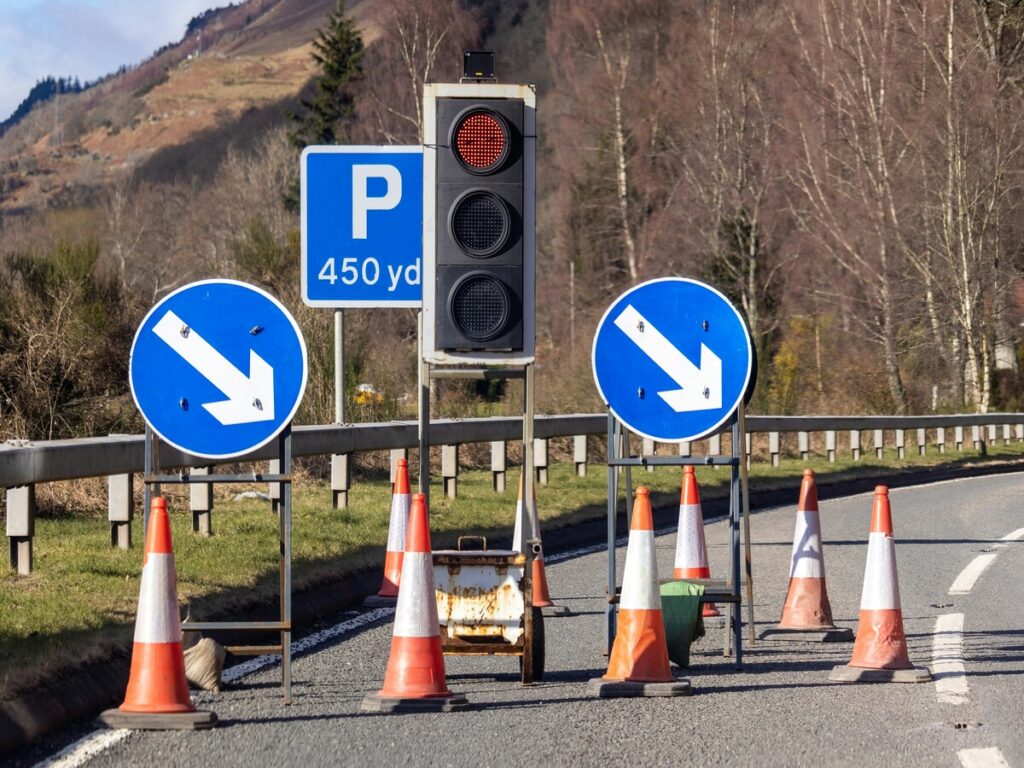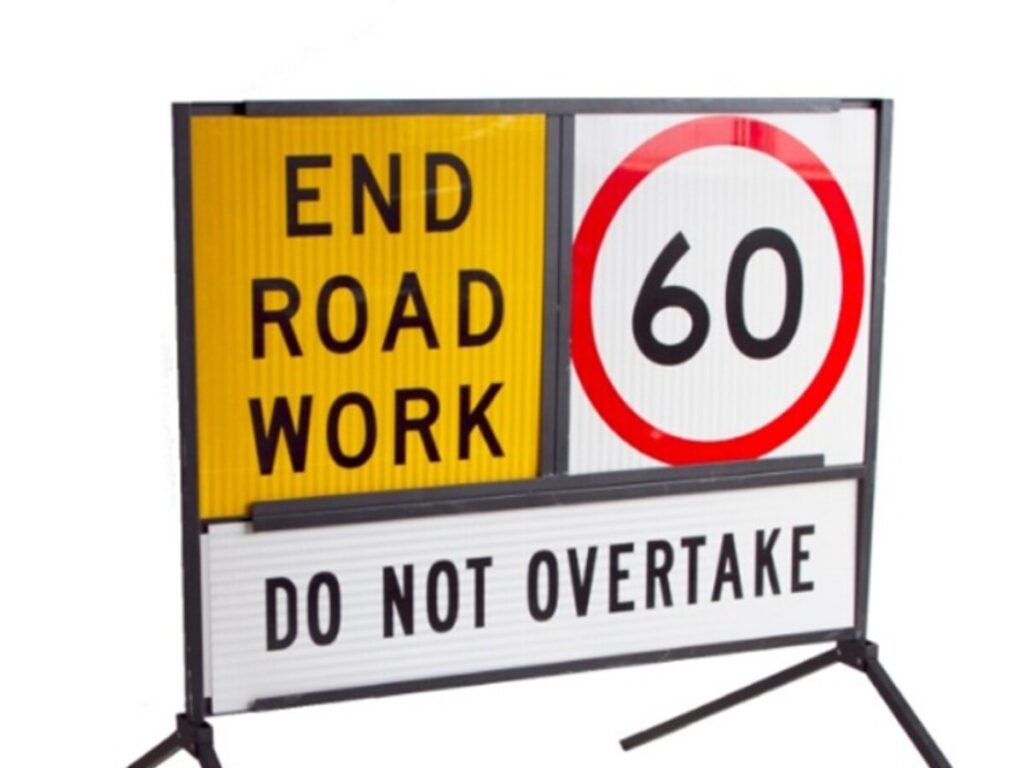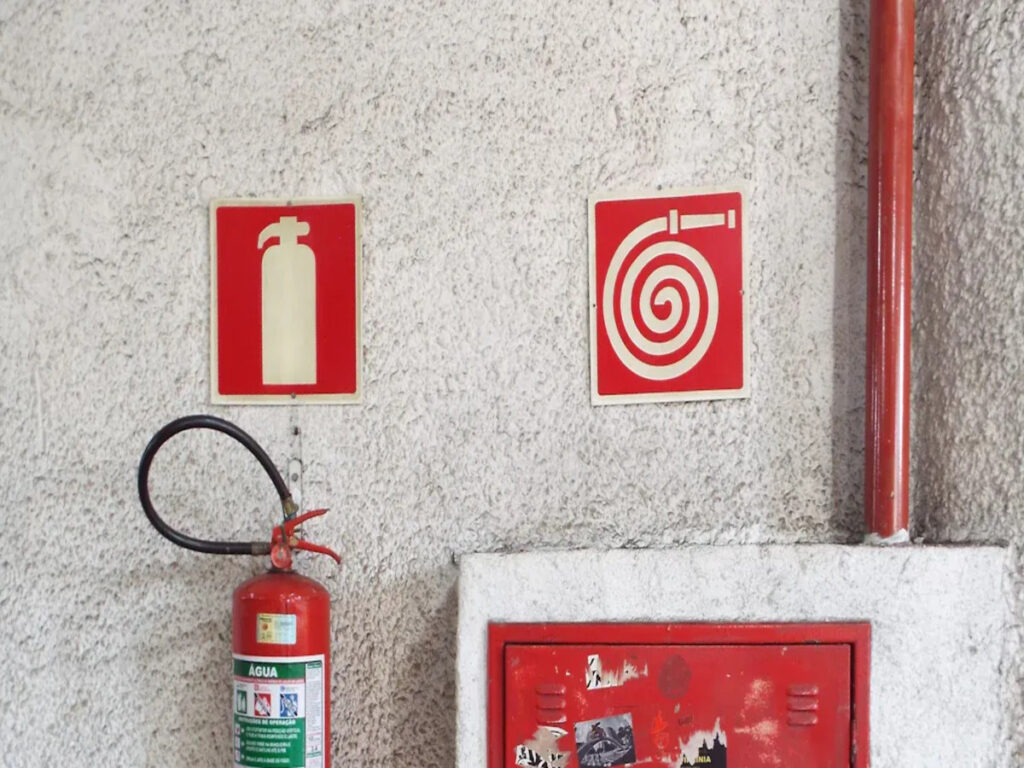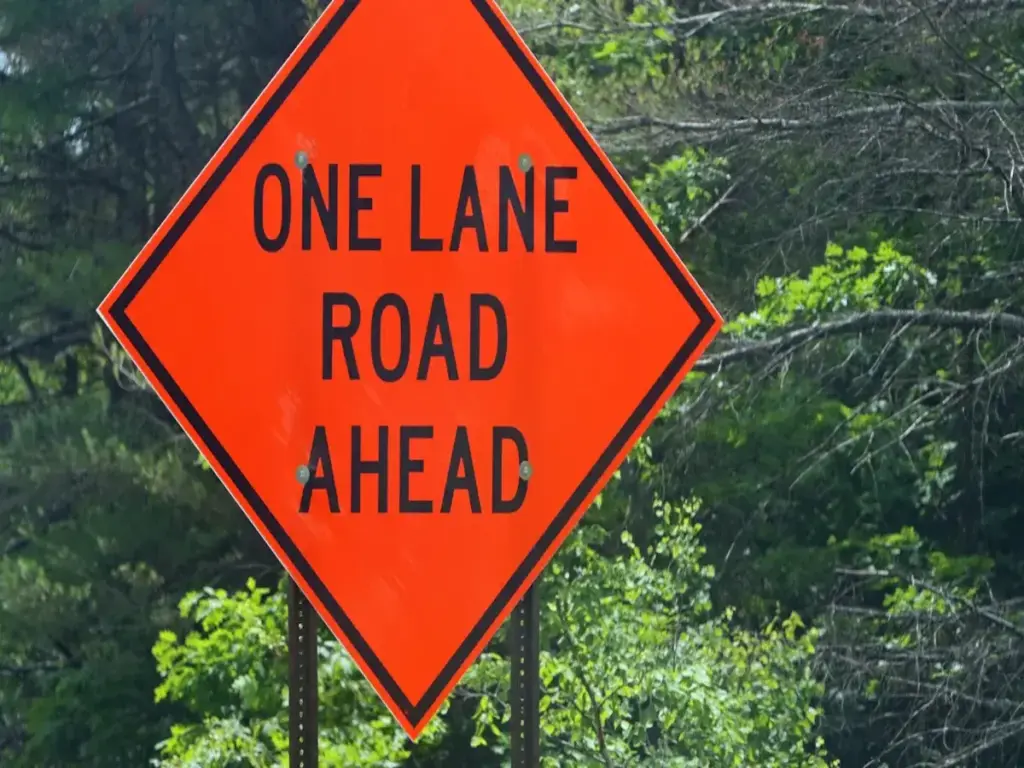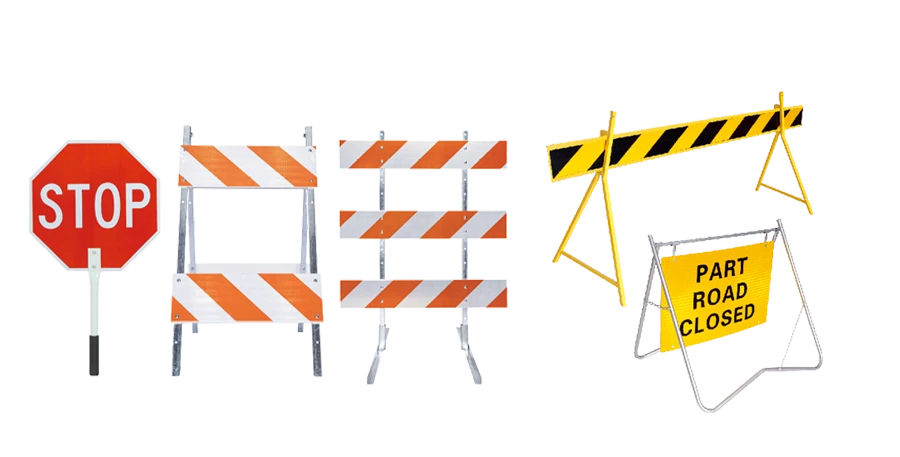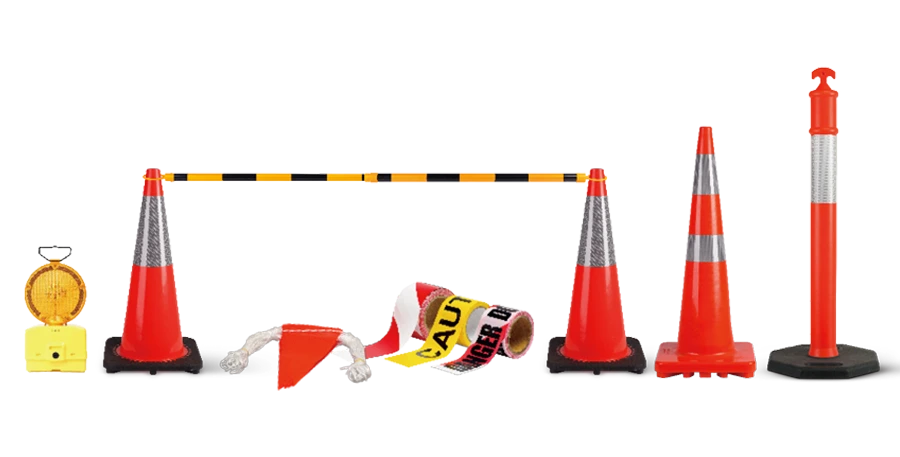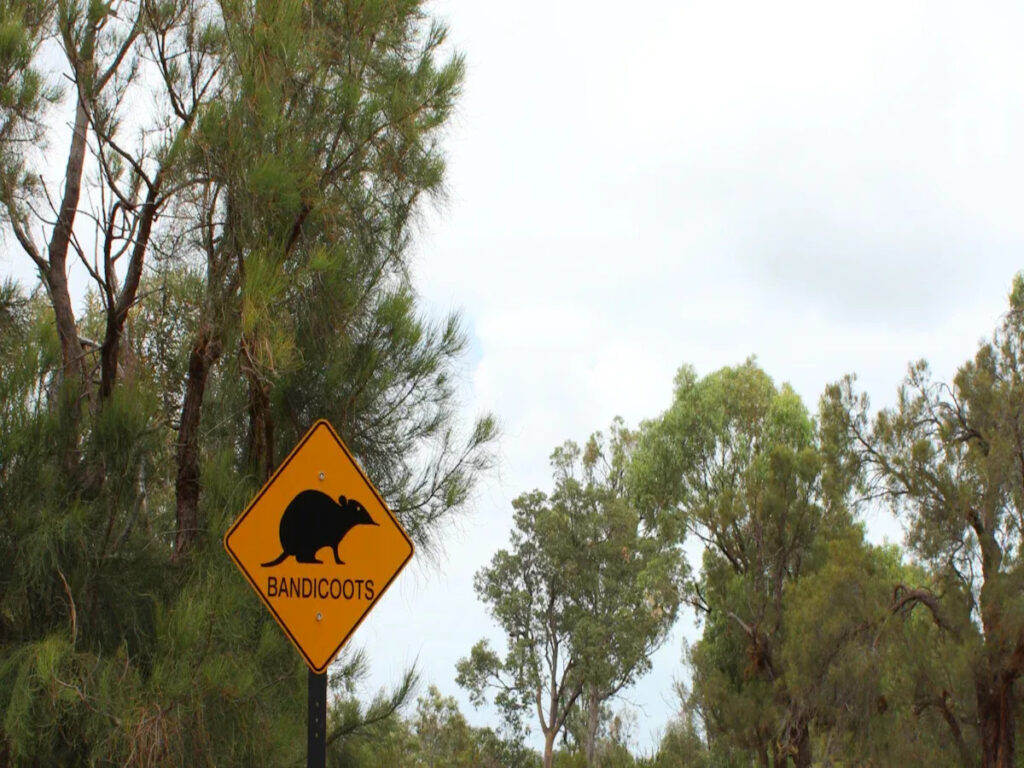
호주 경고 표시는 모양과 크기에 대한 엄격한 규칙을 따라야합니다.. 표준은 표지판이 다이아몬드 또는 삼각형 모양이어야한다고 말합니다.. 노란색 배경과 검은 색 기호가 필요합니다. 서명 크기는 도로 유형 및 속도에 따라 변경됩니다.. 더 빠른 도로에서 더 큰 표시가 사용되므로 운전자는 더 잘 볼 수 있습니다.. 이러한 모양과 크기는 운전자가 위험을 빠르게 발견하는 데 도움이됩니다. 법에 따르면 이러한 특징은 모든 표시가 명확하고 간단하게 읽을 수 있도록 사용되어야합니다.. 처럼 1742.2 모든 호주 경고 표시가 전국 어디에서나 똑같이 보이도록.
광교통 전체 범위를 공급합니다 1742.2 호환 경고 표시, 계약자의 요구를 충족하도록 설계되었습니다, 협의회, 그리고 교통 당국. 지역 거리에서 고속 도로까지, 교통 표지판은 가시성을 보장합니다, 안전, 그리고 전국 규정 준수.
주요 테이크 아웃
- 호주 경고 표시는 다이아몬드 모양입니다. 그들은 노란색 배경과 검은 색 기호를 가지고 있습니다. 이것은 사람들이 빠르게보고 경고를 이해하는 데 도움이됩니다..
- 표시의 크기는 도로 유형 및 속도로 변경됩니다.. 더 빠른 도로에서 더 큰 표시가 사용됩니다. 이것은 운전자에게 더 많은 시간을주고 반응 할 수 있습니다.
- 표지판을 놓아야합니다 65 에게 100 도시의 위험보다 먼저 미터. 시골 도로에서, 그들은해야합니다 150 에게 250 위험 전에 미터. 이것은 운전자가 안전을 유지하는 데 도움이됩니다.
- 표지판을 세워야합니다 1.5 에게 2.0 지상 위의 미터. 그들은 검은 테두리와 둥근 모서리가 필요합니다. 이것은 그들을 쉽게 볼 수 있고 강하게 유지합니다.
- 다음으로 1742.2 규칙은 사고를 막는 데 도움이됩니다. 또한 운전자가 혼란스러워하는 것을 막습니다. 모든 표시가 동일하고 읽기가 간단한 지 확인하여 법적 문제를 방지합니다..
호주 경고 신호: 모양과 의미
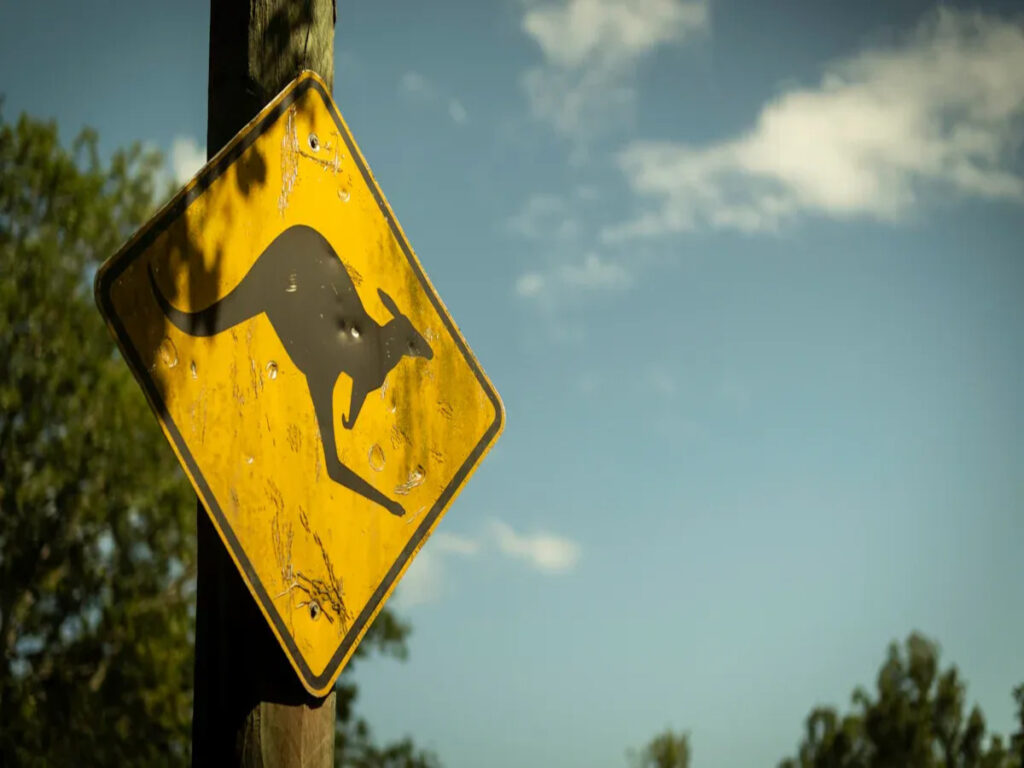
다이아몬드 모양
호주 경고 신호 다이아몬드 모양입니다. 이것은 단지 좋은 생각이 아닙니다. 처럼 1742.2 모든 일반 경고 표시 가이 모양을 사용해야한다고 말합니다. 다이아몬드는 다른 표지판과 다르게 보입니다, 사각형이나 원처럼. 운전자는 멀리서 다이아몬드 모양을 알 수 있습니다. 이것은 그들에게 경고가 앞서 있음을 알립니다. 다이아몬드 모양은 표지판의 색상과 기호와 잘 어울립니다.. 도로에있는 모든 사람에게 명확한 메시지를 전합니다..
색상과 기호
호주 경고 표시는 검은 기호 나 단어로 밝은 노란색을 사용합니다.. 이것은 낮과 밤에 표시를 쉽게 볼 수있게합니다.. 노란색이 눈에.니다, 그리고 검은 색 기호는 읽기 쉽습니다. 일부 징후, 학교 구역 표지판처럼, 황록색과 특별한 반짝이는 소재를 사용하십시오. 이것은 사람들이 날씨가 좋지 않거나 어두울 때 더 잘 볼 수 있도록 도와줍니다.. 기호는 대담하고 단순합니다. 그들은 그림을 사용하여 위험을 보여줍니다, 곡선처럼, 동물, 또는 좁은 길. 기호 크기는 변하지 않습니다, 표시가 더 크다고해도. 이것은 운전자가 경고를 빨리 알고 빠르게 행동하는 데 도움이됩니다.. 이러한 색상과 기호를 사용하면 운전자가 위험을 볼 수 있습니다, 스팟 표시, 그리고 안전을 유지할 시간이 있습니다.
표준화 목적
표준화는 도로 안전에 매우 중요합니다. 모든 경고 표시가 동일하게 보일 때, 운전자는 자신이 의미하는 바를 알고 있습니다. 다이아몬드 모양, 노란색 배경, 검은 기호는 운전자가 1 초 미만으로 경고 표시를 발견하는 데 도움이됩니다.. 연구에 따르면 운전자가 운전자가 표시를 쉽게 이해하고 혼란스럽지 않습니다.. 규칙을 따르는 징후는 쉽게 볼 수 있습니다, 새로운 운전자 나 방문자조차도. 표준 표지판은 강력합니다, 알루미늄 및 컬러 본드 강과 같은 반짝이는 재료. 이것은 날씨 나 밤에 쉽게 볼 수 있도록합니다.. 좋은 배치와 관리가 표시를 차단하지 않도록하십시오.. 표지판이 규칙을 따르지 않는 경우, 운전자는 확실하지 않거나 혼란 스러울 수 있습니다, 특히 새로운 도로에서. 연구에 따르면 표준과 일치하지 않는 징후는 드라이버를 늦추고 더 많은 사고를 유발할 수 있습니다.. 다음에 따라 1742.2, 경고 표시는 모든 사람을 위해 도로를 더 안전하게 유지하는 데 도움이됩니다.
크기와 치수
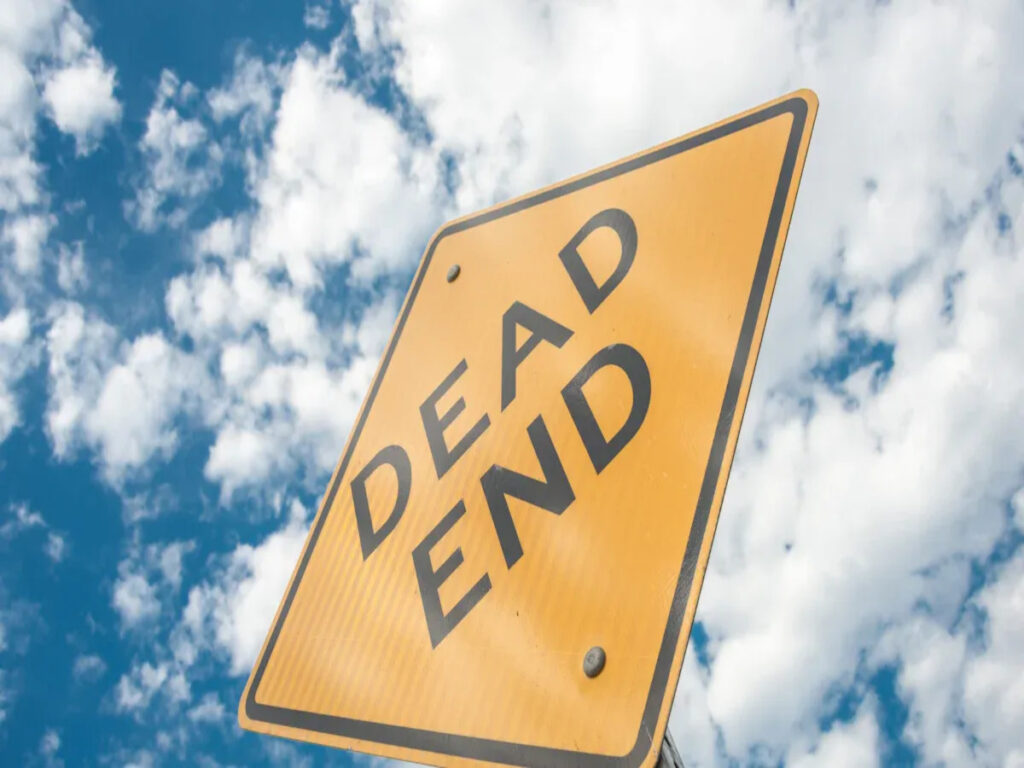
크기 코드
호주 경고 표시는 크기 코드 시스템을 사용합니다. 이 코드는 사람들이 각 도로에 대한 올바른 표시를 선택하는 데 도움이됩니다.. 코드는 시리즈 A에서 시리즈 D로 실행됩니다. 각 시리즈는 다른 도로 유형 및 속도 구역과 일치합니다.. 시리즈 A 및 B 표시가 가장 작습니다. 협의회는 거리가 좁고 시각적 혼란이 많은 도시 지역에서 사용합니다.. 시리즈 C 표시는 중간 크기입니다. 그들은 적당한 속도로 도로에서 잘 작동합니다, 마을과 시골에서. 시리즈 D 표시가 가장 큽니다. 도로 승무원은 고속도로와 빠른 시골 도로에서 사용합니다.. 큰 표지판은 운전자가 멀리서 경고를 볼 수 있도록 도와줍니다.
| 속도 구역 (km/h) | 도로 유형 | 일반적인 사인 크기 시리즈 | 설명 |
|---|---|---|---|
| < 60 | 도시의 | 시리즈 A/B | 공간 제약과 시각적 혼란이있는 저속 도시 지역에 대한 작은 표시. |
| 60–80 | 도시/농촌 | 시리즈 c | 적당한 속도 영역을위한 중간 크기의 표지판, 가시성과 공간의 균형. |
| 100+ | 고속도로/농촌 | 시리즈 d | 원거리 가시성을 보장하기 위해 고속도로 및 고속 도로에 대한 가장 큰 표시. |
팁: 올바른 크기 코드를 선택하면 운전자가 위험을 조기에 발견하고 제 시간에 반응하는 데 도움이됩니다..
메트릭 치수
각 크기 코드는 특정 측정에 연결됩니다. 표준은 밀리미터를 사용하여 물건을 명확하게 유지합니다. 사이에 속도가있는 도시 도로 40 그리고 60 km/h 측정 된 징후를 사용합니다 600 MM. 농촌 도로는 종종 사용됩니다 750 MM 표지판. 고속도로와 고속도로에는 더 큰 표시가 필요합니다, 최대 900 mm 이상. 일부 매우 빠른 도로는 큰 표지판을 사용합니다 1200 MM 또는 심지어 1500 mm. 더 큰 표시는 운전자가 더 멀리 떨어진 곳에서 볼 수 있음을 의미합니다., 자동차가 빨리 움직일 때 중요합니다.
| 속도 구역 (km/h) | 도시 도로 (mm) | 시골 도로 (mm) | 고속도로 & 고속도로 (mm) |
|---|---|---|---|
| 40 - 60 | 600 | 750 | 900 |
| 80 - 100 | 750 | 900 | 1200 |
| 110+ | 900 | 1200 | 1500 (선택 과목) |
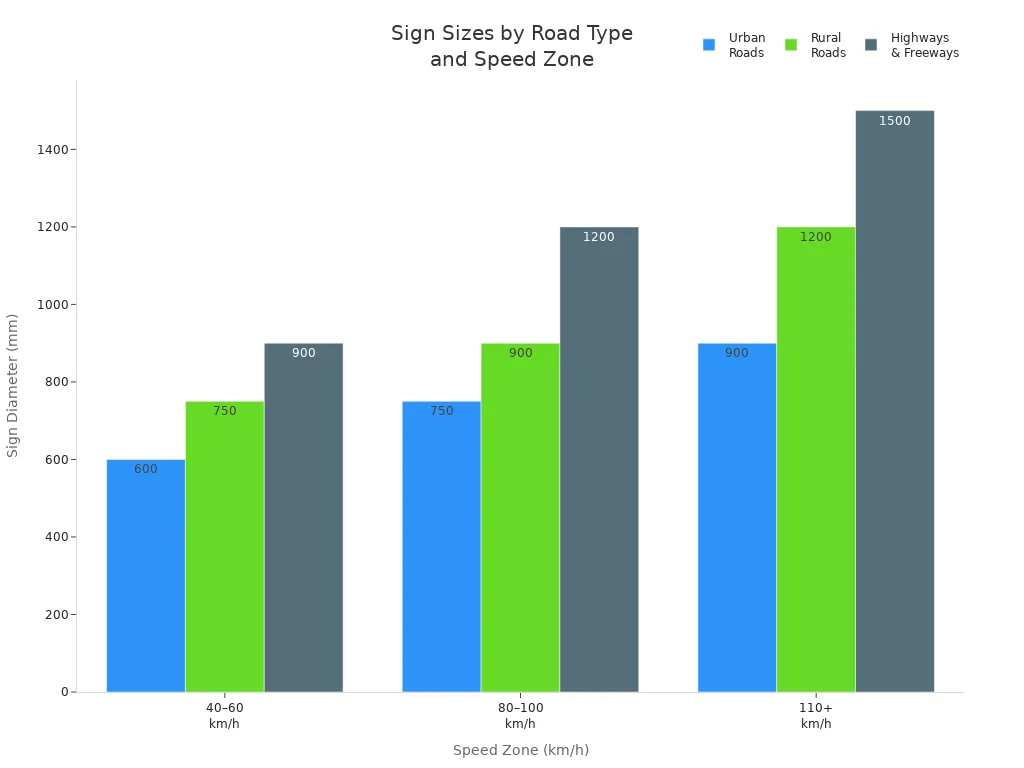
메모: 특수 영역, 학교 지역처럼, 아이들을 안전하게 지키기 위해 도시에서도 더 큰 표지판을 사용할 수 있습니다..
장착 및 비율
적절한 장착은 경고 표시를 쉽게 볼 수있게합니다. 표준은 부호의 바닥을 배치하라고 말합니다. 1.5 에게 2.0 지상 위의 미터. 이 높이는 운전자의 시야에 표시를 넣습니다.. 표지판에는 검은 테두리가 있어야합니다. 테두리 너비는 부호의 크기와 일치해야합니다., 그래서 항상 옳습니다. 대부분의 표지판은 단일 피스 알루미늄 또는 강철 강철을 사용합니다. 모서리는 둥글어야합니다, 날카 롭지 않습니다, 부상과 손상을 방지합니다. 표지판은 똑바로 세워야하며 마른 상태가되어야합니다. 좋은 장착은 바람에서 움직이거나 넘어지는 것을 막는다..
- 장착 높이: 1.5지면에서 기호 바닥으로 –2.0m
- 테두리 너비: 부호 크기에 비례합니다 (보통 10-20 mm)
- 재료: 싱글 피스 알루미늄 또는 강철, 방사선으로 (반올림) 코너
이 규칙을 따르는 징후는 보이고 더 오래 지속됩니다., 힘든 날씨에도.
사용 및 배치
도로 유형
도로 환경에 따라 호주의 경고 신호 변경 크기 및 배치. 도시 거리, 시골 도로, 그리고 고속도로는 각각 다른 요구가 있습니다. 도시 지역은 종종 더 낮은 속도 제한과 시각적 산만 함을 가지고 있습니다.. 작은 표시, 시리즈 A 또는 B에있는 것과 같은 것, 여기서 잘 작동합니다. 농촌 도로는 더 빠른 속도와 더 긴 시력 거리를 봅니다. 시리즈 C 또는 D의 더 큰 표시는 운전자가 위험을 일찍 발견하는 데 도움이됩니다.. 고속도로와 고속도로에는 가장 큰 징후가 필요합니다. 이 도로는 교통량을 빠르게 움직입니다, 따라서 표시는 크고 명확해야합니다.
| 환경 유형 | 크기 시리즈 코드 | 일반적인 경고 표시 크기 (mm) | 설명 |
|---|---|---|---|
| 도시의 (지역 거리, 저속) | 시리즈 A/B | 600–900 | 작은 표지판은 더 낮은 속도와 세심한주의에 적합합니다. 사진은 명확성을 위해 같은 크기를 유지합니다. |
| 시골의 (주요 도로, 더 높은 속도) | 시리즈 C/D | 900–1200 | 더 큰 징후는 더 빠른 속도에서 가독성을 향상시킵니다, 운전자에게 더 많은 반응 시간을 제공합니다. |
| 고속도로 (고속 도로, 고속도로) | 시리즈 d/e | 1200–2400+ | 가장 큰 표시는 최대 가시성과 고속에서 빠른 인식을 보장합니다.. |
운전자를 안전하고 정보를 유지하려면 표지판이 도로 유형과 일치해야합니다..
스피드 존
속도 영역은 경고 표시의 크기와 배치 모두에 영향을 미칩니다.. 속도 제한이 낮은 도로에서, ~와 같은 50 또는 60 km/h, 작은 징후로 충분합니다. 운전자는 경고를보고 이해할 시간이 더 있습니다.. 속도가 높은 도로에서, 좋다 100 또는 110 km/h, 표지판은 더 크고 앞으로 더 배치해야합니다. 이것은 운전자에게 반응하기에 충분한 시간을 제공합니다. 표준은 그림 크기를 동일하게 유지합니다, 표시가 커지더라도. 이것은 운전자가 경고를 신속하게 인식하는 데 도움이됩니다.
배치 거리
경고 표시의 올바른 배치는 안전에 필수적입니다. 도시 지역에서, 표지판이 서 있어야합니다 65 에게 100 위험 전에 미터. 시골 도로와 고속도로에서, 거리가 증가합니다 150 에게 250 미터. 이 여분의 공간을 통해 운전자는 표시를 볼 수 있습니다, 메시지를 처리하십시오, 그리고 안전하게 행동하십시오. 표지판은 항상 눈에 띄는 상태를 유지해야합니다. 나무가 없습니다, 기둥, 또는 주차 된 차량은 차량을 차단해야합니다. 곡선이나 언덕이 표시를 숨기는 경우, 추가 표시가 필요할 수 있습니다. 쉽게 볼 수 있도록 표지판은 올바른 높이와 각도에 앉아 있어야합니다..
적절한 배치 및 사이징은 모든 운전자가 경고를 유지하고 안전하게 유지하도록 도와줍니다., 그들이 어디로 여행하든.
준수 및 식별
표준 표지판 인식
누구나 경고 표시가 충족되는지 확인할 수 있습니다 1742.2 몇 가지 주요 기능을 살펴보면. 표시는 노란색 배경과 검은 색 기호의 다이아몬드 모양을 가져야합니다.. 크기는 도로 유형과 속도 구역과 일치해야합니다.. 글꼴은 AS 여야합니다 1744 운송 시리즈, 명확하고 읽기 쉽습니다. 재료는 단일 피스 알루미늄 또는 둥근 모서리가있는 강철이어야합니다.. 표시는 올바른 높이에 앉아 있어야합니다, 대개 1.5 에게 2.0 지상 위의 미터. 반사 표면은 운전자가 밤이나 날씨가 열악한 표지판을 보는 데 도움이됩니다.. 이 세부 사항은 호주 경고 표시를 쉽게 발견하고 이해할 수 있도록합니다..
일반적인 실수
사람들이 표준을 따르지 않으면 실수가 발생할 수 있습니다.. 몇 가지 일반적인 문제에는 다음과 같습니다:
- 잘못된 모양을 사용합니다, 다이아몬드 대신 사각형과 같은.
- 도로 속도의 잘못된 크기를 선택합니다.
- 비표준 글꼴 또는 색상 사용.
- 부호를 너무 낮거나 너무 높게 배치합니다.
- 검은 테두리를 잊거나 날카로운 모서리를 사용합니다.
- 반사 재료를 사용하지 않습니다.
이러한 오류는 운전자를 혼동하고 안전을 줄일 수 있습니다. 표준을 충족하지 않는 징후도 법적 문제로 이어질 수 있습니다..
확인 단계
단계별 접근 방식으로 규정 준수 표시를 확인하는 것은 간단합니다.:
- 도로 유형의 올바른 크기를 확인하려면 부호를 측정하십시오..
- 모양을 확인하십시오, 색상, 그리고 국경.
- 명확성을 위해 글꼴과 기호를 검사하십시오.
- 재료를보고 모서리가 둥글다는 것을 확인하십시오..
- 장착 높이를 확인하고보기를 차단하지 않음.
- 밤에 반사율을 테스트하십시오.
AS를 준수하지 않습니다 1742.2 사이에 벌금을 부과 할 수 있습니다 $100 그리고 $300, Demerit 포인트, 또는 법원 행동조차도. 표지판이 충돌을 일으키거나 학교 구역과 같은 민감한 지역에있는 경우 처벌이 증가합니다.. 표준 충족은 운전자를 보호하고 법적 위험을 줄입니다.
협의회와 계약자는 기록을 유지하고 최신 버전의 AS와 상담해야합니다. 1742.2. 이를 통해 모든 표시가 안전하고 합법적으로 유지됩니다.
처럼 1742.2 명확한 규칙을 만들어 도로 사고를 중단하는 데 도움이됩니다. 이 규칙은 얼마나 큰지 말합니다, 어디, 그리고 호주의 경고 표시가 얼마나 반짝이는지. 연구에 따르면 좋은 징후는 충돌을 최대까지 낮추는 것으로 나타났습니다. 25%. 도로 당국은 신뢰할 수있는 공급 업체로부터 표지판을 구매해야합니다. 그들은 기록을 유지하고 자주 표시를 확인해야합니다. 표준 호주 및 전문가는 질문에 답하거나 새로운 사인 아이디어에 도움을 줄 수 있습니다.. 이러한 일을하면 모든 도로 사용자를 안전하게 유지하는 데 도움이됩니다.
이 규칙을 뒷받침하는 프레임 워크에 대해 자세히 알아 보려면, 블로그를 참조하십시오: 이해 관계 1742: 호주 교통 표지 규정의 기초.
FAQ
호주의 경고 표시는 어떤 형태로 있어야합니다 1742.2?
호주 경고 표시는 다이아몬드 모양을 사용해야합니다. 이 모양은 운전자가 경고를 신속하게 인식하는 데 도움이됩니다. 다이아몬드는 다른 도로 표지판에서 돋보입니다.
경고 표시가 노란색과 검은 색을 사용하는 이유는 무엇입니까??
노란색과 검은 색상은 경고 표시를 쉽게 볼 수 있습니다.. 노란색은 일광과 밤에 두드러집니다. 검은 기호 또는 단어는 메시지를 명확하게 보여줍니다.
경고 표시가 얼마나 위험에 처해야 하는가?
도시 도로에서, 표지판은 위험이 발생하기 전에 65-100m에 서 있어야합니다. 시골 도로 또는 고속도로에서, 거리는 150-250 미터로 증가합니다. 이것은 운전자에게 반응하기에 충분한 시간을 제공합니다.
경고 표시가 1742.2?
사람은 모양을 확인할 수 있습니다, 크기, 색상, 세례반, 그리고 장착 높이. 표시는 다이아몬드 모양을 사용해야합니다, 노란색 배경, 검은 기호, 그리고 도로의 올바른 크기. 반사 재료도 중요합니다.



